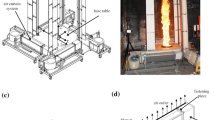Abstract
The knowledge of the fire safety distance of the multiple pool fires is essential to model, manage, and mitigate the fire hazardous scenarios to safeguard the surrounding people, buildings and equipment. In this work, experiments are performed on 0.1 m gasoline double pool fires to calculate the fire safety distances using an infrared imaging technique. The distance (S/D) between the two pool is varied from 0 to 1. The irradiance from the two pools is calculated using the two-dimensional temperature field obtained by an IR camera. The calculated irradiance along the flame axial direction and on the ground is presented in a contour format. The safety distances are also represented as a function of their respective flame lengths. Two threshold heat fluxes: (I) 1.4 kW/m2 and (II) 4.7 kW/m2 which are required for human safety are emphasised in the contour plots for all the configurations.




















Similar content being viewed by others
References
Abdalla AM, Hossain S, Nisfindy OB, Azad AT, Dawood M, Azad AK (2018) Hydrogen production, storage, transportation and key challenges with applications: a review. Energy Convers Manag 165:602–627
Sepehri A, Sarrafzadeh M-H (2018) Effect of nitrifiers community on fouling mitigation and nitrification efficiency in a membrane bioreactor. Chem Eng Process Intensif 128:10–18
Sharma RK, Gopalaswami N, Gurjar BR, Agrawal R (2020) Assessment of failure and consequences analysis of an accident: a case study. Eng Fail Anal 109:104192
Vasanth S, Tauseef SM, Abbasi T, Abbasi SA (2014) Multiple pool fires: occurrence, simulation, modeling and management. J Loss Prev Process Ind 29:103–121
Major fire at IOC’s Hazira terminal—The Hindu (2009)
Atallah S, Allan DS (1971) Safe separation distances from liquid fuel fires. Fire Technol 7:47–56
Zárate L, Arnaldos J, Casal J (2008) Establishing safety distances for wildland fires. Fire Saf J 43:565–575
Butler BW, Cohen JD (1998) Firefighter safety zones: a theoretical model based on radiative heating. Int J Wildl Fire 8:73–77
Rossi J-L, Simeoni A, Moretti B, Leroy-Cancellieri V (2011) An analytical model based on radiative heating for the determination of safety distances for wildland fires. Fire Saf J 46:520–527
Sudheer S, Kumar L, Manjunath BS, Pasi A, Meenakshi G, Prabhu SV (2013) Fire safety distances for open pool fires. Infrared Phys Technol 61:265–273
Raj VC, Prabhu SV (2018) Measurement of geometric and radiative properties of heptane pool fires. Fire Saf J 96:13–26
Modak AT (1977) Thermal radiation from pool fires. Combust Flame 29:177–192
McGrattan KB, Baum HR, Hamins A (2000) Thermal radiation from large pool fires. US Department of Commerce (USA), National Institute of Standards and Technology, Gaithersburg
Shokri M, Beyler CL (1989) Radiation from large pool fires. J Fire Prot Eng 1:141–149
Hurley MJ, Gottuk DT, Hall JR Jr, Harada K, Kuligowski ED, Puchovsky M, Watts JM Jr, Wieczorek CJ et al (2016) SFPE handbook of fire protection engineering. Springer, New York, pp 94–107
Liu Q, Liu N, Huang X (2017) Radiative heat transfer from multiple discrete fires. J Fire Sci 35:535–546
Wan H, Gao Z, Ji J, Sun J, Zhang Y, Li K (2018) Predicting heat fluxes received by horizontal targets from two buoyant turbulent diffusion flames of propane burning in still air. Combust Flame 190:260–269
Wan H, Gao Z, Ji J, Zhang Y (2019) Experimental study on flame radiant heat flux from two heptane storage pools and its application to estimating safety distance. Energy 182:11–20
Zhao K, Wang Z, Ma S, Ju X, Guo P, Cao X (2022) Experimental study on the diffusion burning and radiative heat delivery of two adjacent heptane pool fires. Int J Therm Sci 171:107246
Sudheer S, Prabhu S (2013) Characterization of hexane pool fires using infrared thermography. J Fire Sci 31:143–165
Hayasaka H, Koseki H, Tashiro Y (1992) Radiation measurements in large-scale kerosene pool flames using high-speed thermography. Fire Technol 28:110–122
Munoz M, Arnaldos J, Casal J, Planas E (2004) Analysis of the geometric and radiative characteristics of hydrocarbon pool fires. Combust Flame 139:263–277
Howell J (2008) A catalog of radiation heat transfer configuration factors. http://www.thermalradiation.net/indexCat.html
Bathina SK, Siddapureddy S (2023) Effect of spacing between the double pool fires on the flame emissiviy and temperature. Fire Technol 59(5):2481–2497
Acknowledgements
This work was supported by the Science and Engineering Research Board (SRG/2019/001347).
Author information
Authors and Affiliations
Corresponding author
Ethics declarations
Conflict of interest
The authors declare that they have no known conflict of interest.
Additional information
Publisher's Note
Springer Nature remains neutral with regard to jurisdictional claims in published maps and institutional affiliations.
Rights and permissions
Springer Nature or its licensor (e.g. a society or other partner) holds exclusive rights to this article under a publishing agreement with the author(s) or other rightsholder(s); author self-archiving of the accepted manuscript version of this article is solely governed by the terms of such publishing agreement and applicable law.
About this article
Cite this article
Bathina, S.K., Siddapureddy, S. Fire Safety Distances of Double Pool Fires. Fire Technol (2024). https://doi.org/10.1007/s10694-024-01562-4
Received:
Accepted:
Published:
DOI: https://doi.org/10.1007/s10694-024-01562-4




